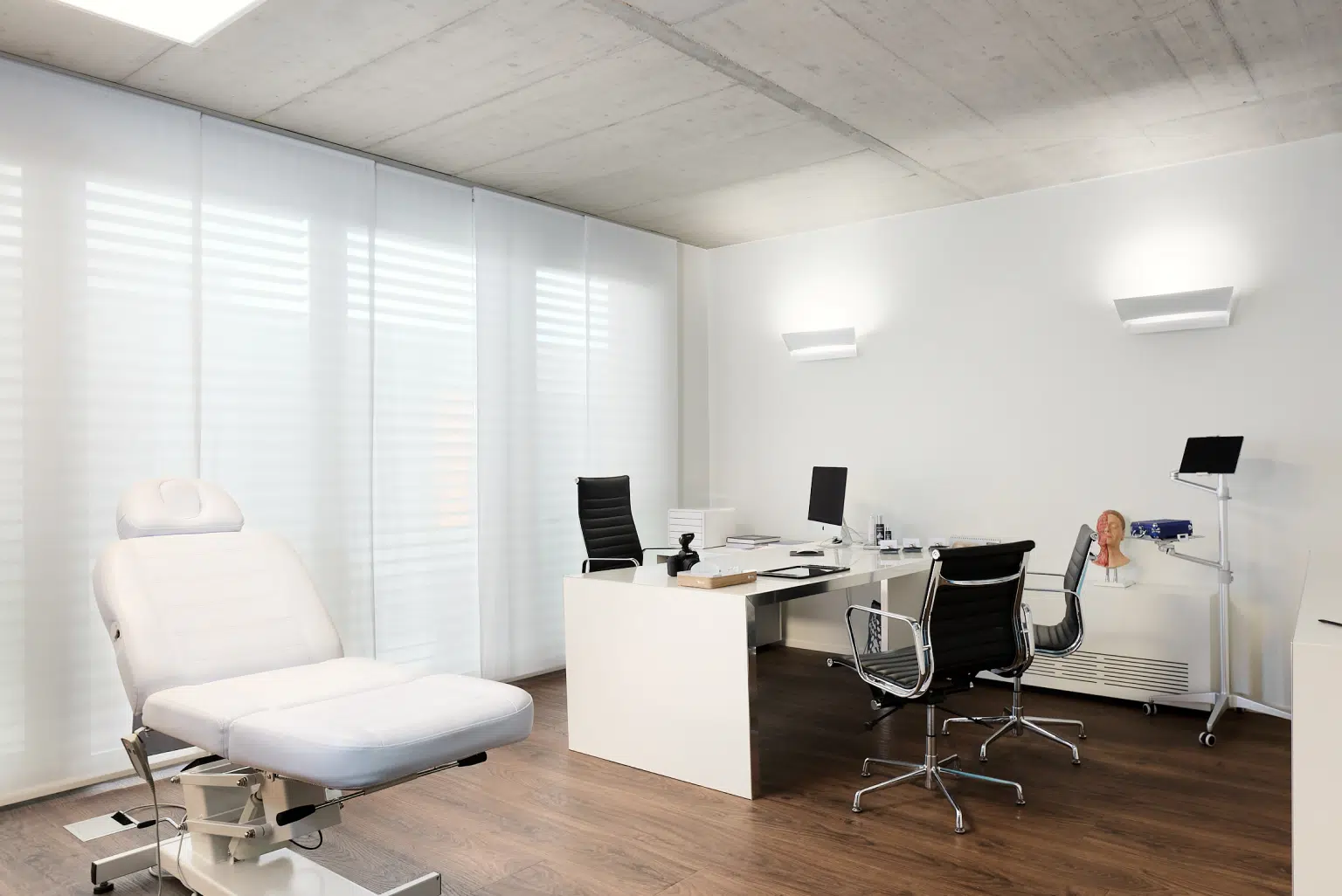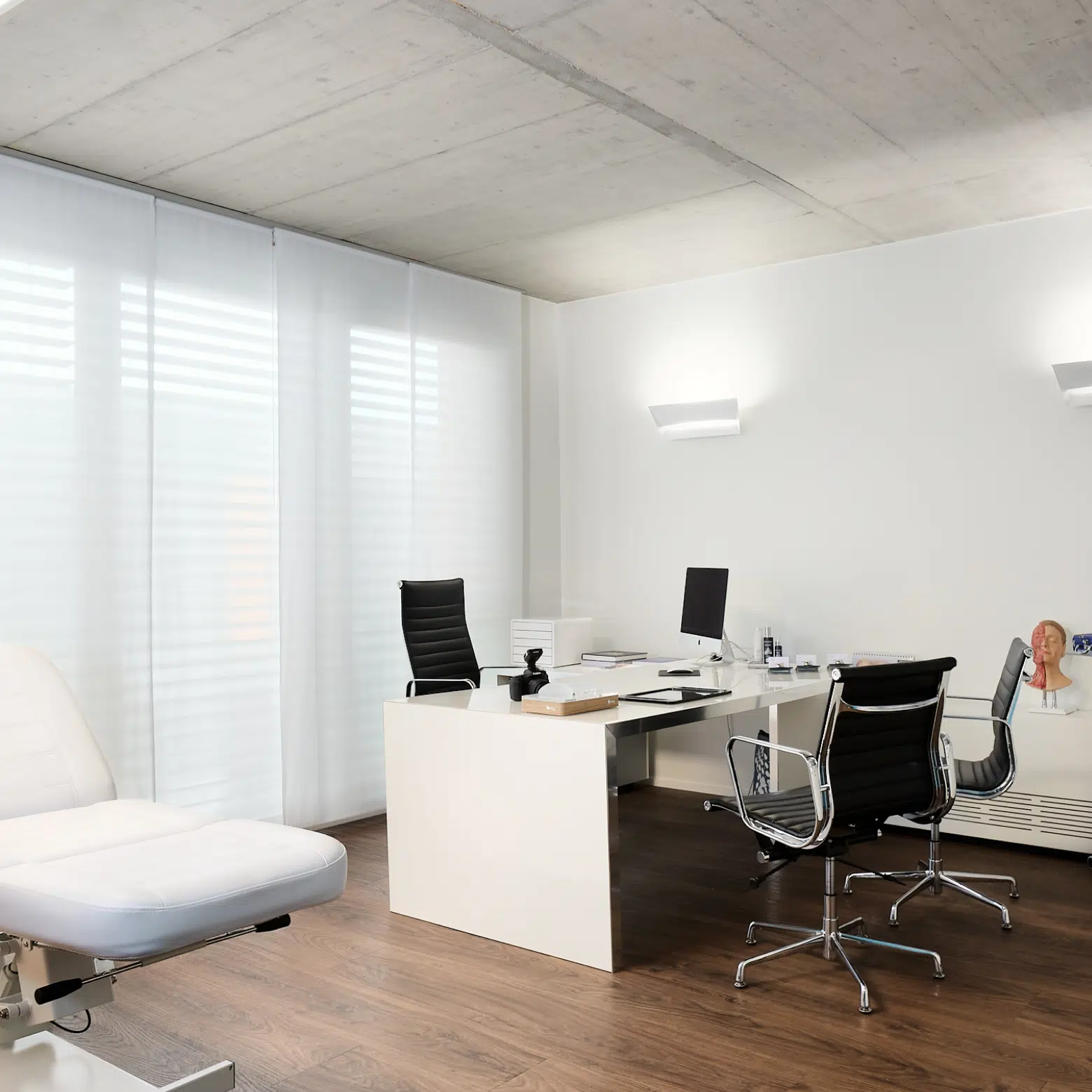Parcours patient
Pour une prise en charge personnalisée et fluide, depuis la première consultation jusqu’au suivi post-traitement, en garantissant écoute, expertise et transparence à chaque étape.


Types d’anesthésie
Anesthésie générale
Dans ce type d’anesthésie, le patient est complètement endormi et la respiration contrôlée par l’anesthésiste. C’est l’anesthésie préférée pour les procédures longues, afin d’assurer le confort tant pour le patient que pour le chirurgien. Contrairement à ce qui est généralement pensé, l’anesthésie générale est l’une des techniques les plus sûres, car le médecin est en total contrôle des voies aériennes du patient. Ce type d’anesthésie ne peut pas être effectué si l’on n’a pas respecté un temps de jeûne approprié, en général d’au moins 6 heures. Il est également contre-indiqué en cas de fièvre, rhume ou autres maladies non contrôlés.
Anesthésie locale avec sédation
Ce type d’anesthésie est une combinaison d’une anesthésie locale, avec une anesthésie livrée par le sang, également appelée sédation. De cette manière, on peut obtenir un patient détendu, sans douleur et sans aucun mauvais souvenir. Cela permettra d’éviter l’intubation et les effets secondaires de l’anesthésie générale, comme sont les nausées. Ce type d’anesthésie ne peut pas être effectué si l’on n’a pas respecté un temps de jeûne approprié, en général d’au moins 6 heures.
Anesthésie locale
C’est le type d’anesthésie de choix pour la plupart de nos traitements. L’anesthésie est infiltrée localement, ce qui bloque la transmission de la douleur. De cette façon, nous pouvons bloquer une zone de traitement (par exemple les paupières) ou certains nerfs spécifiques (p.ex. un nerf d’un doigt). Compte tenu de son faible taux de complications, l’anesthésie locale est notre anesthésique de choix pour tous les cas ambulatoires, à condition qu’elle puisse être faite. Le jeûne n’est pas nécessaire pour cette méthode. En cas de patient angoissé, nous proposerons un médicament anti-stress par voie orale.
Complications générales
Comme tout acte de notre vie, la chirurgie n’est pas démunie de risques et de possibles complications. Heureusement, ces complications sont rares dans les mains d’un chirurgien certifié. De plus, beaucoup de ces complications sont transitoires, réversibles ou possibles de corriger. Si le chirurgien et le patient travaillent ensemble, les résultats indésirables seront réduits.
Le chirurgien doit évaluer si le patient est un bon candidat pour le traitement souhaité. Les patients qui comprennent les recommandations du médecin et qui sont disciplinés, verront diminuer le risque de complications. Les complications générales les plus fréquentes de toute chirurgie plastique sont :
Cicatrices inesthétiques
Toute intervention qui comprend une incision de la peau, entraîne une cicatrice. La bonne cicatrisation dépend de cinq facteurs: l’emplacement de la cicatrice, le type de peau, la tension à la fermeture, le soin de la plaie et l’état général du patient.Certaines parties du corps guérissent mieux que d’autres, généralement les cicatrices orientées dans le sens des plis naturels et sur de la peau mince sont pratiquement invisibles. Certains types de peau (par exemple, la peau sombre) ont une plus grande tendance à former des cicatrices épaisses et de vraies chéloïdes. Une cicatrice soumise à une grande tension est plus sujette à un élargissement de celle-ci. Une cicatrice est définitive après 2 ans chez l’adulte et 5 ans chez l’enfant.
Hématomes et ecchymoses
Il y a différentes formes pour nommer un saignement après une intervention. Les ecchymoses, connues habituellement sous le nom de« bleus », sont un effet tout à fait normal et disparaissent généralement au bout de deux semaines. Par contre, un vrai hématome est une collection de sang coagulé qui prend de la place et qui se résorbe beaucoup plus lentement.Malgré la bonne maîtrise du saignement à la fin de l’intervention, le risque d’hématome est présent au cours des dix premiers jours. Pour réduire ce risque il faudra éviter les médicaments qui empêchent la coagulation (aspirine, Sintron, Plavix, AINS), le stress soutenu, les efforts importants et toutes activités qui peuvent provoquer une montée de la pression artérielle. En cas d’hématome important, il faut immédiatement avertir votre chirurgien.
Séromes
Si un hématome est une collection de sang, un sérome est une collection de liquide clair, qui s’accumule dans les interventions dans lequel le système de drainage lymphatique est perturbé. Ces épanchements sont généralement absorbés spontanément, mais une ponction peut s’avérer nécessaire en fonction de leur volume.
Infections
Toute plaie est exposée à l’infection. Les infections sont très rares en chirurgie plastique, car toutes les précautions sont prises pour les éviter. Les interventions qui impliquent un corps étranger (par exemple une prothèse mammaire) sont plus sensibles à l’infection, c’est pourquoi les précautions sont redoublées dans ce genre d’intervention.
Autres
- Modification de la sensibilité
Parfois, la peau autour d’une cicatrice est engourdie. Cet engourdissement peut persister pendant plusieurs mois et ne doit pas être source de préoccupation. La sensibilité est généralement récupérée complètement après quelques mois.
- Déhiscence et nécrose cutanée
Assez rarement, les plaies peuvent s’écarter, s’élargir ou souffrir jusqu’à la formation d’une croûte. Ces complications font que la cicatrisation est prolongée, au-delà des 10 jours habituels.
- Réaction aux sutures
Les patients trop sensibles peuvent faire une réaction aux points de suture, ce qui est plus fréquent avec l’utilisation des sutures résorbables. Dans ces cas, vous verrez une réaction inflammatoire locale de la plaie, comme une petite éruption cutanée qui finit par être expulsée de la suture. Cela ne doit pas être confondu avec une infection et son traitement est très simple.
- Asymétrie et insuffisance du résultat
La chirurgie est un art et une profession dans laquelle l’on travaille avec des tissus vivants et sans l’utilisation de mesures de précision fine. C’est pourquoi il ya toujours la possibilité d’une légère asymétrie dans le résultat. Par ailleurs, toutes les personnes ont un certain degré d’asymétrie que ce soit au visage ou au corps.La plupart des asymétries postopératoires sont généralement bien acceptées et n’ont pas besoin de correction.
- Thrombose veineuse
Les chirurgies prolongées et sous anesthésie générale comportent plus de risques généraux, comme une thrombose (caillot) dans les veines des jambes. Il s’agit d’une complication potentiellement grave, raison pour laquelle toutes les mesures préventives sont prises pour réduire les risques.
Notre équipe travaille afin de limiter les risques et les complications. Chaque semaine, des dizaines d’interventions sont effectuées par notre équipe, sans aucune complication. Cependant, chaque patient doit être conscient que tout traitement comporte des risques, quel que soit le type d’intervention. C’est pourquoi il est important que le patient comprenne et accepte les risques associés à la chirurgie. Avant de subir une intervention, il est très important de bien s’informer. Votre médecin est la meilleure source d’information et vous donnera des renseignements sur les risques habituels d’un tel traitement, comme sur votre risque individuel.
Tarifs habituels
Le coût d’une chirurgie esthétique dépendra de cinq facteurs : de la modalité d’anesthésie, de la nécessité d’un séjour en clinique, du temps opératoire, de l’utilisation de produits spéciaux (p.ex. implants) et de la difficulté technique de l’intervention.
C’est pourquoi il est difficile de donner des estimations sans avoir discuté et examiné un patient. Vous aurez alors un devis précis du traitement proposé à la fin de votre première consultation.
Néanmoins, certaines interventions « classiques » peuvent bénéficier d’un tarif forfaitaire ce qui englobera la totalité de la prise en charge.
Paiement échelonné
Nous savons que les traitements peuvent être coûteux, c’est pourquoi nous avons décidé de travailler avec un partenaire financier Suisse pour offrir à nos patients des options de paiement flexibles.
A la Leman Aesthetic Clinic, nous nous engageons à proposer à nos patients l’accès aux meilleurs soins, leur bien-être étant notre priorité.
Catherine
Publié le 13 décembre 2025
Désireuse de renseignements sur la chirurgie du visage 54 ans
Leman Aesthetic Clinic
Publié le 16 décembre 2025
Bonjour,
Merci pour votre message. Nous serions ravis de vous fournir des renseignements concernant la chirurgie du visage.
Les options et tarifs varient selon vos besoins, c’est pourquoi une consultation est recommandée afin d’évaluer votre situation et répondre à vos questions.
Vous pouvez nous contacter au +41 22 346 59 59 ou prendre rendez-vous via OneDoc.
Liliana
Publié le 30 octobre 2025
Désire de renseignements sur chirurgie mammaire
Leman Aesthetic Clinic
Publié le 20 novembre 2025
Bonjour,
Merci pour votre message. Nous serions ravis de vous fournir des renseignements concernant la chirurgie mammaire.
Les options et tarifs varient selon vos besoins, c’est pourquoi une consultation est recommandée afin d’évaluer votre situation et répondre à vos questions.
Vous pouvez nous contacter au +41 22 346 59 59 ou prendre rendez-vous via OneDoc.